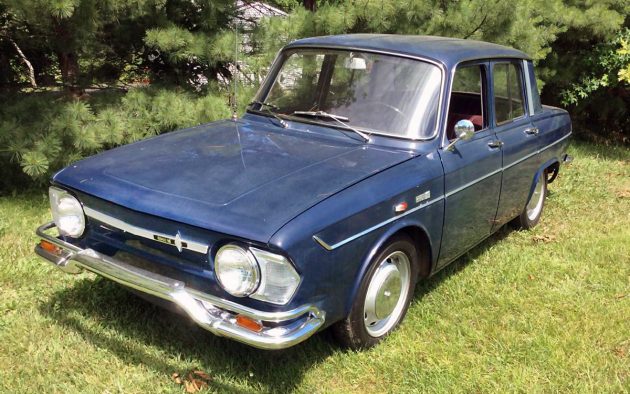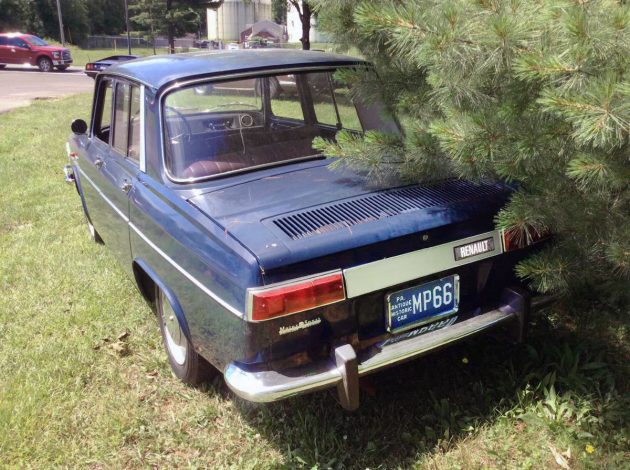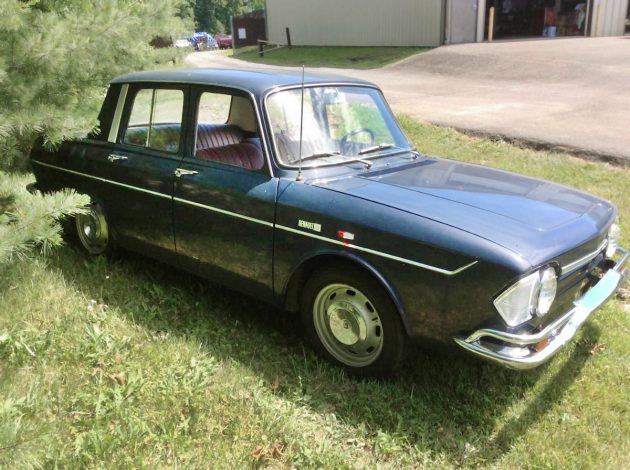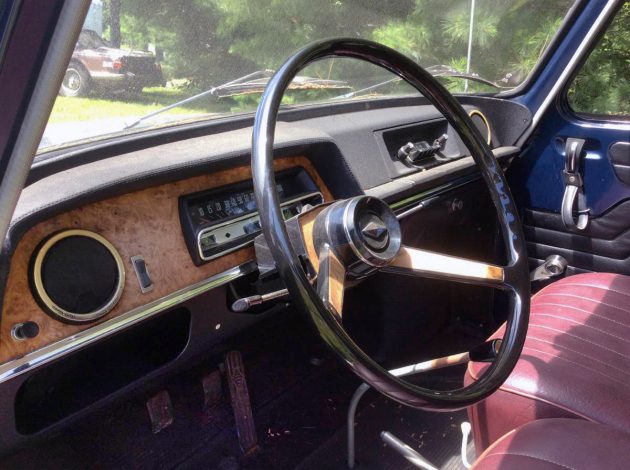Franophiles, here’s a 1967 Renault 10 in really nice shape. It can be found on craigslist with an asking price of $4,900 or best offer. That may seem like the absolute top of the market for a car like this, but this one only has 32,000 miles on it and it’s still wearing its original tires! Yeah, you may want to change those.
This car would look fantastic with a little work on the paint, buffing, not repainting. There’s no mention of rust at all and I don’t see any, but there has to be some rust somewhere, doesn’t there? The Renault 10, or R-10, was introduced to the public in the fall of 1965 and production ended in 1971.
I love the look of these cars, sort of a push-me-pull-you design. I guess the car that was one of its main competitors, the VW Beetle, also had a similar which-is-the-front-which-is-the-back look to it. This is a coveted round headlight car, being an early-1967 model. This car “runs and drives good” but needs brake work. I don’t know what that consists of, but hopefully it isn’t anything too major. And, yes, supposedly there are just 32,000 miles on this car and it sure looks like it’s true given it’s superb condition. Supposedly, it’s best to walk away from a rusty R-10 as there are others available, this one doesn’t appear to be one of those rusty cars.
This car looks almost perfect to me, inside and out. The seats are perfect, and who doesn’t love a red interior! All of that French vinyl! And, did I mention that this car “even has the original Michelin “Made in France” tires still on it!” The R-10 was the last of the rear-engine Renaults, being replaced by the Renault 12. Unfortunately, there are no engine photos, which seems strange with the seller being a restoration shop in Warminster, Pennsylvania, but this one should have a 1.1L inline-four with just under 50 hp. Have any of you owned a Renault 10? This sure seems like the nicest one that I’ve seen.








Had a friend who owned an R10 some years ago, and I did quite a bit of work on it (engine rebuild, major brake service, etc.). Nice cars and, as you’d expect from the French, unusually comfortable for their size.
Mechanically, they are pretty straightforward, once you get past the minor quirks of wet-liner engines and the four-wheel disc brakes (IIRC, the calipers were of a strange design, but presented no real problems). As with any Renault, I’d be concerned about parts availability; the days when boneyards were full of these things seem to be over.
It’s difficult for me to get my head around the price, though, as it seems only yesterday that decent examples could be bought for sums in the low three figures. Yeah, I’m getting old. Can’t really see these as desirable classics — the smaller and faster R8 Gordini could push me over the edge, though — but they are fun runabouts and, when maintained properly, pretty reliable.
Well, at least with this one you can verify the mileage. The tires should be date coded, if they are not, they are ancient and probably original.
Well, if anyone needs it, I have supposedly a decent rebuilt engine for this car at reasonable price, along with front & rear bumpers, but then this one looks like it doesn’t need anything. Same engine as the two ’67 Caravelles I used to have – funny thing was, the engine evidently had such a small flywheel and low torque in the Caravelles that I had to rev the bejesus out of the engine and slip the clutch in 1st gear to get it moving on my basically all-grass driveway in Michigan. Just didn’t want to get moving without lots of revs! Felt like I was scorching the clutch every time in 1st.
RayT, sure agree with you on the weird calipers front & back – my Caravelles had pistons with center pins and retractor circlips that in some way were supposed to pull the pistons back a hair from the discs to avoid drag & excessive wear on the pads. Of course no one does that with modern calipers, as the seals do all the retracting necessary. Due to the center retractor pin and other bits, you were supposed to orient the pin with the split in its ring spring at 12:00, or you could trap air in the piston center when bleeding them. Also, the retractor pin extended back thru the rear caliper block wall and was held there by a nut. Way too many extra, unnecessary parts as I saw it. They worked, but you could basically throw away the guts in the piston and just plug the rear hole and they would work. Gotta remember, it’s early Francophile stuff……
Hey Ken, this is a very late reply but wondering if you happen to still have the bumpers you mentioned? I’m not sure if this will ever get to you, but taking a chance. MY husband and I are the ones that bought this little car and are really having fun with it!
Yes i still have them – where are you located? you can reach me directly at [email protected], or twoforeate V one V nine ate 7 nein. Contact me before july 24th as I’m heading for Ca. Aug 1, and will have to check here in Mich. before I leave, then Ca. when I get there – can’t remember where I have them but think it’s Ca.
I had a ’67 and an R12 as well. Loved the R10. Loved the driving experience of the R12 too but reliability was sketchy.
Compared to the beetle, the R10 had two more doors, bigger trunk, better heater because it was water cooled, and 4-wheel discs. Engine had 5 mains and wet sleeves. You could buy new pistons and cylinders in a kit and rebuild in your driveway. Spare stored behind a door under the trunk.
Name another car with 4-wheel discs from that era.
I had a 1969 very similar to this one in 1986-1987. Inside was the same but, outside was white. It was in perfect shape but, it was that year’s “Winter Beater”. It ran great and I had no complaints. Bought it for $300 – drove it for 6 months – sold it for $300.
Good little car for me.
Had a 69 which I bought for $300.00. It was in perfect condition, red exterior with black interior. Very basic 4 doors, standard on the floor l. Loved zipping to and from work in it, until an old man ran a stop sign and t-boned me. Would love to have it now.
Way back when I had my paper route, I had a customer who was into French cars as daily drivers. He had one of these – it was nothing like the other vehicles in my area.
I’m a hard core cyclist, and in addition to old cars I collect old road bikes. This would be a nice match with my vintage French cycle, a lugged steel 1972 Peugeot PX-10. But that could start a troublesome new theme in my collection. What would I buy to go with my modern carbon fiber Bianchi?
– John
An Ariel Atom?
Wow, I remember seeing these around when I was a kid. I completely forgot about them.
Same here. I remember kids being dropped off in cars like these at primary school way back when I had to bike to school. Growing up in Europe was exiting in the 1960’s car-wise. I can still hear the typically normal ‘leaky muffler’ sound in my ears when they pulled away from the kerb.
Didn’t see near as many of these as the Dauphine. With power up a whopping 255cc’s from 845cc’s of the Dauphine,( which I believe this, or the 8 replaced) that may be why. I mean, in ’67 we were driving land yachts that could burn the hides with 10 times the hp, why would you want an anemic car like this? Don’t get me wrong, French build great cars, just not for I-80 in a strong head wind.
The comment earlier about finding parts for this in a bone yard. Last summer I had to go to five yards here in New England to find a stock steel rim (15″) for my 1994 F150. I started out thinking I’d have a choice at the first yard I went to. I guess in the scrap price boom a few years ago this stuff was sent away for wads of cash.
I bought one for $25.00, it had the bad clutch fork, so I keep the jack and tool kit and scraped it, 35 years ago, the car was sweet!
https://www.youtube.com/watch?v=S3TLBUvayr0
I bought a near perfect one in Biloxi around 1967. Had the pushbutton automatic, which was just solenoids operating the 3 speed manual trans. The brain box for that died, and I remember paying about $90 for a new one plus labor. Seats were very comfortable – as were those on my later Simca 1000, 4 door. Had very skinny tires and if you had to pop the brakes in an emergency, it would lock and slide all 4. I had a very close call like that when an idiot pulled across Hwy. 90 on the beach at Long Beach, Ms. as I going pretty good – with a load of kids in the car. I still count that near miss as one of my “9 lives”. The R-10 would have come apart like an eggshell. I think I may have traded it in for an excellent $1,300 Sunbeam Tiger. It was a great little car though and I would buy this one for sure – if I didn’t already have 6 projects in my garage.
Wow!! Saw this car last week parked at a body shop while visiting my folks. It looked in decent shape. Very clean. There is also a 73 vw ghia there for sale that needs restoration.
Why do you suppose they backed it into the bushes for the photo shoot? Typical CL poor photography? Or perhaps something to hide?
Much nicer than the R 10 I drove back in the early 1980’s in high school. I really liked that car a lot and have only seen one since then.
The cool thing was the drop down door under the front bumper that reviled a spare tire compartment.
The car was so small I could open all the windows without getting out of the drivers seat. Plus it was roomy enough to put 3 of my friends in it.
The best thing was the gas mileage, I drove that car so far on so little fuel
I also giggle about the rule of 4 with this car, 4 door, 4 speed, 4 cylinder, 4 wheel disc brakes. and 3 lug nuts ….
Had 1 after the Dauphien & B4 the Simca 1000 (I think that’s the correct order). They were all mom’s cars (fam’s “2nd car”). Late 60s early 70s she went to the fiat 850s then onto the 124 or spyders. Our family musta increased our wealth (or may B just our cool factor?). Didn’t Maxwell Smart drive a Simca down a flight of stairs in the opening credits? Ahhh, my early daze…
As I heard, all the Renaults after ’63 went to 4 wheel discs, as both of my ”67 Caravelles had them. However, they had one of the strangest caliper designs I’ve ever seen – very similar to my ’64 Bristol 408 Mk I coupe with a Chrysler 313 V8 tweaked to 250 HP, with Dunlop power brake system.
The strange bit was that both the Renault caliper and Bristol pistons had retracting devices in the center backside of them – to supposedly keep the pads from dragging on the discs. Evidently no one in those early days understood that the seals themselves automatically retract the pistons so they don’t drag. The center retractors on the Ren. pistons had a spring ring inside the back, and riding on a central pin which was bolted thru the rear end of the piston housing. Extra parts, extra machining, which did nothing but make maintenance more complicated. Instructions were to make sure the spring split ring in the Ren. design had its split at TDC, so as to avoid trapping air inside that internal chamber and reducing braking response – i.e., incomplete air bleed.
The Brits were worse – their retractor had a pile of little spring parts, along with a very strange piston design, which used instead of a round or square cross-section Oring, used a large rubber washer, which had to be stretched over the piston quite a bit, and was a very funky design overall. having worked on the very early disc brake Citroens, which went to front discs in 1955, and which taught me a lot, I eliminated the center retractors on the Bristol, and have had absolutely no problem since then and they’re as simple as can be now.
Now I only have R16s, best Renault I know of. Rides almost as good as a hydropneumatic Citroen, which does have the best ride in the world.